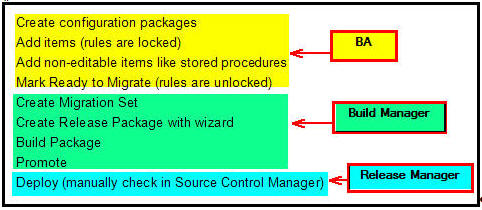Release Management Security
Security plays an important role in the Release Management process. The Security Manager will need to set security levels for configurors and managers who will be involved in the process. The image below shows a typical security breakdown but it can be modified to meet specific business needs. The Release Management folders will not be visible to users unless they have received the proper security role.
Refer to the Rules Palette Security section for details on creating Release Management Security Roles.

Suggested Security Breakdown for Release Management
Version History
There is also a level of security applied to the data to protect the integrity of the environment where configuration packages are created. When a rule or transaction is checked-out, a snapshot of the item is taken and stored in the Version History folder. The item then becomes locked and can only be edited by the user who checked it out for the configuration package. If another user tries to check-out that item, a message will appear indicating that the item is locked by another user. This prevents rules from being overwritten while they are in the release process.
Once a configuration package is complete, the BA will mark it as Ready to Migrate. At this point, the rules and transactions that were locked will become unlocked and will be available for other users to edit and use.
If a configuration package is placed on hold, the rules and transactions are released and made available to users. This is done to keep the flow of business moving. If the rules and transactions marked for the on-hold configuration package are changed, they will also be changed in the configuration package, since they are no longer locked. When resuming work on an on-hold configuration package, review the attached rules and transactions.
Copyright © 2009, 2014, Oracle and/or its affiliates. All rights reserved. Legal Notices